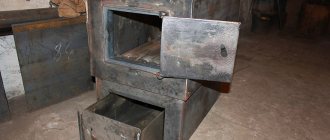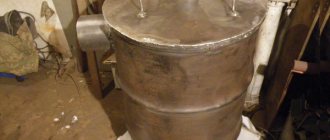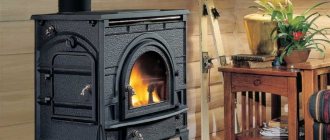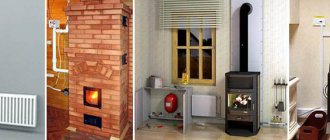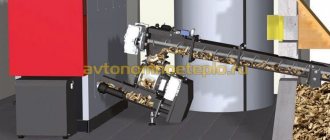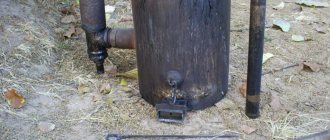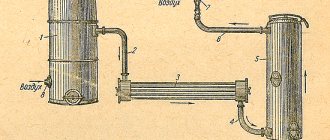Sawdust is an excellent material for heating houses and greenhouses.
They are made of wood, which means that when used correctly, they are only slightly inferior in heat capacity to firewood.
You can get them cheaply , and in some cases even for free .
Next we will tell you about different methods of heating different rooms with sawdust:
- houses;
- makeshift;
- greenhouses
We will also consider in detail all types of heating stoves and long-burning boilers that can use sawdust as fuel.
How sawdust burns
Before talking about the features of sawdust boiler houses, it is necessary to understand the combustion mechanism of this fuel itself, because it is very different from the combustion mechanism of wood.
No matter how tightly the firewood is stacked, air always passes , and in sufficient quantity to support combustion.
Even loose sawdust allows much less air , so smoldering quickly dies out without supplying additional air to the combustion zone.
Sawdust burners only work effectively when the fire moves from top to bottom . Therefore, only a layer of sawdust 2–5 cm thick constantly burns.
Due to the fact that only a small amount of fuel is involved in combustion, the power of sawdust boilers and stoves operating on them, while being the same as wood and coal heating appliances, is 2–3 times less .
Another factor that reduces the power of a boiler or furnace is the low combustion temperature of sawdust.
If wood burns with the correct air supply, the flame temperature exceeds 1000 degrees, often reaching 2000 degrees in the tongues of fire. Moreover, this is a powerful fire , because the entire mass of firewood emits pyrolysis gases.
The fire temperature of burning sawdust, even with proper air supply, does not always reach 1000 degrees due to the weak flow of pyrolysis gases .
Pyrolysis gases effectively exit only from the top layer 5–15 mm .
Gas comes out with difficulty from burning or heated sawdust located below, because the sawdust located above interferes with it.
Despite such disadvantages, sawdust is ideal for long-burning boilers and furnaces.
After all, well-compacted sawdust burns for a very long time .
Often, a homemade iron stove burns for 5–8 days with one load of sawdust, providing heating for the entire house.
Positive characteristics of a sawdust stove
The stove option under consideration has its advantages, namely:
- Such a creation will begin to produce heat immediately after the sawdust smoldering. Within half an hour, the cold air in the house will turn into warm air and the room will be comfortable.
- This oven is quite convenient to use. When assembled according to the rules, it will be safe to use. The efficiency of such a furnace is significantly higher compared to any standard design that runs on solid fuel.
- Sawdust is still the cheapest fuel in Russia, thanks to this the population has another way to save.
Suitable heating systems
For heating private houses and any buildings with sawdust, the following systems :
- heating stoves;
- heating stoves with a water heating register or heater;
- water heating with radiators;
- water heated floor;
- air heating;
- air heated floor.
Heating stoves heat the space around them , so they are suitable only for small houses . At a distance of 10 meters from the stove, the temperature drops by 10–15 degrees, so in large houses the stove can only act as an additional heater.
Heating stoves with a water heating register or heater combine the advantages of stoves and boilers. They provide the same heat as a conventional heating furnace and heat the coolant, which is supplied through pipes or ducts to remote rooms.
The large mass of the stove turns it into a heat accumulator , thanks to which you do not have to re-light the boiler every 2 hours or add firewood to it every hour. The stove will maintain the coolant temperature for up to 6–10 hours , so you can heat it 2–3 times a day.
Water heating with radiators in each room can be used with either a water boiler or a sawdust stove if it has a water register . Like any other water heating, it can operate on natural or forced circulation of coolant.
natural circulation systems, hot water first rises to the ceiling, then descends into each room and flows either to the radiators or to the heated floor. In systems with forced circulation, water is driven by a pump, so all pipes can be laid under the floor.
Water and air heated floors not only heat the room, but also improve its microclimate. In winter, it is very pleasant to walk barefoot on the floor, feeling its warmth with your feet. The main disadvantage of a heated floor is the high cost of materials and work, because it is necessary not only to lay air ducts or a water pipe, but also to properly insulate the space between the floor and the ground or foundation.
Air heating is just as expensive as underfloor heating, because it is necessary to lay air ducts throughout the house, as well as install automatic humidifiers due to the strong drying of the air. Ovens with heaters can be used as a heat source.
The only difference between furnaces and boilers is that the boiler has
a water jacket , that is, the space between the hot body and the outer casing is filled with water.
Here are the distinctive features of each heating device:
- stove - direct heating of the air and surrounding space;
- heater - heating air for delivery to other rooms without heating the surrounding space;
- stove-heater - heating the surrounding space and heating air for delivery to other rooms;
- stove with register - heating the surrounding space and water for delivery to other rooms;
- boiler - heating water for delivery to other rooms.
Therefore, air heaters and boilers are installed in utility rooms and are often insulated from the outside. After all, it makes no sense to waste thermal energy on strong heating of the utility room, and the less heat spent on this, the more will go to other rooms.
Boiler installation on a permanent basis
“Underground” installation of a boiler with thermal insulation
If there are no problems with sawdust in your region, and this heating method is the most profitable, you can install this boiler more efficiently and conveniently.
The figure shows the boiler installation diagram:
- A pit of the appropriate size was dug for its installation.
- A foundation is laid at the bottom of the pit.
- The walls of the pit must be strengthened against crumbling.
- The boiler is installed in a pit.
- Thermal insulation is installed around the boiler, inside the pit.
- The boiler cover is thermally insulated separately so that it can be removed.
- Coolant pipelines are connected.
- The register is also insulated.
- The chimney is connected.
- The boiler is ready for operation.
Requirements for heating devices
For heating with sawdust, it is necessary to use long-burning boilers and stoves that meet the following conditions :
- fuel combustion from top to bottom ;
- large outer surface area (important for stoves);
- large area of the heat exchanger or water jacket;
- large volume of firebox ;
- possibility of supplying air to the combustion zone.
Due to the small size of sawdust, they can be fed into the stove or boiler automatically, which further increases the battery life of the heating device. Most often, an auger feed is used for this - a rotating auger lifts or lowers sawdust from the hopper and scatters it in the combustion zone.
When there is too much ash, the heater is stopped and cooled to clear the ash and reload it with fuel.
Boilers and long-burning stoves of the Stropuva type (Russian analogue of Bubafonya) are well suited for heating with sawdust. These devices implement the principle of top combustion of wood , and air enters directly into the combustion zone.
Long-burning stoves and boilers running on sawdust can not only be bought, but also made with your own hands. Homemade devices also implement the requirements for heating devices described above.
Long-burning stove using wood waste (sawdust, wood chips, branches)
You can heat a utility room, greenhouse, workshop, or garage with a stove into which sawdust and other waste from the wood industry are compacted. In some regions they can be found for free, or extremely cheaply, which is why such stoves are popular. The advantages include the fact that after lighting it, you don’t have to approach this stove during the entire period of fuel combustion, which can be extended for 12 hours or more.
Sawdust stove design
Fuel combustion occurs in a round or square container with a volume of approximately 100 liters, which is considered optimal in terms of the duration of work on one load, and the possibility of burning the entire stored volume. A round hole approximately 110 mm in diameter is made in the bottom of the container in the center for air supply.
This container is placed in another with larger dimensions, such that there is a gap of at least 50 mm between their sides. For example, you can take two barrels - one for a hundred liters, and the other for 180 liters.
In a large container on the bottom in the center there is an ashpit-ashpit - an oblong box, and the hole in the first container is directly above this ashpit. Thus, air enters the small container from below.
At the top of the large container, along the edge of the sides, there is a sand castle on which the lid is installed. To do this, a corner is welded around the perimeter, and the resulting gutter is filled with sand. The sides of the lid rest on it, thus ensuring tightness.
For a square shape, the optimal dimensions are 40x40 cm for an internal container, and 50x50 cm for an external one, with a height of 1 meter or a little more.
How does a long-burning sawdust stove work?
A long pipe with a diameter of 100 mm or more is installed in the hole in the center of the small container (the combustion power depends on the diameter), then the container is filled with sawdust, into which larger wood elements can be mixed, the sawdust is compacted, after which the pipe is carefully removed. The stove contains a fuel container with a through hole in the center.
All that remains is to set fire to the filling from below; for this, wood chips are placed in the ash box and set on fire. The fuel burns out from the center to the edges, air is supplied from below, passes through the fuel and the already hot gases fall down between the sides of the large and small tanks, and go to the chimney connected at the bottom of the large body.
Thus, the stove initially has a large body area, which only increases the percentage of heat delivered.
How the sawdust stove works - watch the video.
Is it possible to warm up from a potbelly stove - the real power of a sawdust stove
How much energy is contained in the buried sawdust?
- Let us take the average calorific value of large pine sawdust as 2.5 kW/kg.
- The mass of sawdust in the barrel is about 20 kg, with a bulk density of about 200 kg/m3, and a filling volume of approximately 100 liters.
- The energy from combustion of the entire volume is 50 kW.
- If the combustion is extended over 12 hours, then on average we get 4 kW/hour.
Taking into account the efficiency of no more than 50%, we get the real heat output of our stove to be no more than that of an electric heater of 2.0 kW. Which, in principle, is enough to warm up a medium-sized garage or workshop, while being significantly cheaper than electric heating.
But, of course, it will not be possible to obtain greater energy output and quickly warm up a cold room using sawdust...
Ways to increase energy efficiency
Sometimes you need to get more power, for example, 5 kW instead of 2 - this is not difficult to achieve.
- Use dry sawdust, dried for a long time in a warm place; their real calorific value can be up to 1.5 times greater than that of wet sawdust.
- Transfer sawdust with small dry firewood, their calorific value is even higher - up to 4.0 kW per kg.
- Burn faster - make the hole in the filling larger in diameter - the initial volume of fuel combustion increases, giving the maximum amount of air...
In addition to increasing the quantity and quality of fuel, the energy efficiency of the structure itself can also be increased, i.e. Efficiency
- Make vertical fins on the body.
- Leave a large length of the chimney inside the room - make an inclined chimney to the far wall with hatches for cleaning soot.
To quickly warm up the room and increase energy efficiency, you can put a small stack of firewood in the stove, which will burn happily...
Another video about the design of a sawdust stove and its operating features
Furnaces and boilers for working on sawdust
There are 2 types of fireboxes, which differ in the method of air supply :
- from above , through a descending air duct;
- from below , through a pre-made channel in the sawdust.
The most famous furnaces and boilers of the first type are devices under the Stropuva brand. They are produced both in the form of stoves and boilers.
As we already said in the article (Fuel from sawdust), the difference between stoves and boilers is that the former heat the air directly , and the latter heat the coolant . Then the coolant, which can be either water or air, flows through pipes into the rooms and heats them.
With drop-down duct
Long-burning furnaces and boilers in Stropuv are designed as follows :
- the body is made of pipe with a diameter of 50–70 cm ;
- two doors cut into this housing - a loading door on top and a cleaning door on the bottom;
- a telescopic pipe passes through the lid (in homemade devices it is replaced by a regular long-length pipe) - an air duct;
- a steel circle with a thickness of 10 and a width slightly less than the internal diameter of the housing is welded to the bottom of the air duct
- a chain or steel cable is attached to the upper side of the disk to lift the air duct;
- corners or channels are welded to the bottom side of the disk , creating an optimal gap between the disk and the fuel;
- The smoke exit hole is made slightly above the cleaning door.
The following boilers and furnaces operate on sawdust:
- by lifting the air duct using a cable or chain, the stove or boiler is loaded with sawdust, compacting it as much as possible;
- Having loaded sawdust, kindling is placed - paper and various wood chips;
- after waiting for the kindling to flare up, lower the air duct and close the loading door;
- the air supply is set to maximum , due to which the top layer of sawdust flares up and the stove/boiler goes into operating mode;
- fire and smoke rise through the space between the disc and the housing and heat both the duct and the housing ;
- the furnace begins to radiate heat , and the boiler heats the water jacket ;
- As the sawdust burns, its level becomes lower and the air duct descends after it, this system ensures a constant flow of air into the combustion zone and an optimal fuel combustion mode .
With bottom air supply
Boilers and furnaces without a lowering duct are designed and operate slightly differently. Their air duct approaches the firebox from below .
Such heating devices are loaded through a hinged lid . The chimney is connected just below the hinged cover.
The hinged lid is sealed with asbestos cord or tape.
During loading, a long cone-shaped wooden plug is inserted into the air duct (the upper diameter is 1.5–3 times larger than the lower one).
The sawdust is compacted tightly and after loading is completed, the plug is pulled out - air flows through the resulting channel to the upper burning layer of sawdust.
Kindling is placed on the sawdust and set on fire. When the kindling has flared up, close the hinged lid, setting the chimney damper and the air supply regulator to maximum draft mode.
After the sawdust has flared up, the air supply is reduced and the stove or boiler goes into a prolonged burning (smoldering) mode.
How does a sawdust stove work?
The operating principle of a long-burning sawdust stove is based on the main temperature processes:
- Heat accumulation as a result of smoldering wood fuel and gas utilization through it into the chimney.
- The release of heat from smoldering fuel and the removal of pyrolysis gases into the chimney through the external circuit after they have completely cooled.
Slow burning ensures high heat transfer of heating equipment, reducing fuel consumption and the total number of loads.
One load of fuel is designed for 8-10 hours of smoldering with the accumulation of a sufficient amount of thermal energy. In addition, such a stove is equipped with a regulator for dosing the internal volume of air during the combustion process.
After sawdust is loaded into the fuel compartment, all inlet openings are closed to reduce the influx of air masses from the outside. The smoldering process is accompanied by the release of pyrolysis gas, which contributes to the accumulation of large amounts of heat.
Stoves, boilers and heaters: which is better
When choosing sawdust heating, you must consider the following:
- the volume of water in the water jacket of the boiler should be 10–15% of the total volume of water in the heating system, therefore it is advisable to use forced movement of water through thin tubes;
- Stropuva water boiler 65 thousand rubles , and the price of sawdust boilers made by yourself is 30–50 thousand rubles , including the cost of material;
- air heating not only heats, but also dries the air ;
- water heating pipes can be hidden under the finishing, but air heating pipes will have to be laid in plain sight due to their large cross-section (pipe diameter in cm is equal to half the area of the room in m²);
- it is very difficult to find long-burning industrial heaters (boilers and furnaces that heat air, which is then supplied through pipes through pipes) using sawdust , and their cost often exceeds the price of the Stropuva boiler;
- the cost of manufacturing air heaters is comparable to the cost of manufacturing a boiler;
- the costs of material and installation of water and air heating are approximately the same and amount to 15–20 thousand rubles for one room measuring 15–20 m2;
- the cost of manufacturing a stove is 20–50 thousand rubles , depending on the size.
Heaters and boilers are well suited for heating large houses , because they heat the coolant, which then flows through pipes or ducts to remote rooms. For small houses, it is preferable to have a stove installed at the junction of all rooms.
If someone is not satisfied with the appearance of an iron stove , it can be covered with a brick grate - it will improve the appearance of the stove and will not interfere with air movement.
Features of using the oven
The operation of sawdust stoves has significant differences from traditional wood or coal devices. Fuel is loaded into a special fuel chamber, which is completely filled up to the chimney pipe. Thin branches, paper or rags soaked in a flammable mixture are laid on top of the sawdust mass. Next, the press is installed, and the chamber is closed with a lid.
After the combustion process begins, the damper remains motionless, and the device is warmed up until the next fuel supply.
Important! In a long-burning sawdust stove, you cannot add additional fuel in the middle of the process. The device does not open until the sawdust is completely burned.
The combustion process itself begins in the center of the embedded fuel mass, then moves to the circumference of the walls. As it smolders, the compressed sawdust significantly decreases in volume, which ensures a burning duration of up to 10 hours.
The heat transfer coefficient of a sawdust stove directly depends on the diameter and volume of the fuel chamber. Long and tapered designs provide accelerated heating, while large-diameter devices provide slow heating and high heat transfer.
Chimney outlets
If there is supposed to be only one pipe, you need to find the optimal location for its exit - in the middle and a little closer to the top.
By slightly complicating the design with a second hole, you can achieve better draft and be able to control the combustion process.
One hole is located at the top of the body, the other at the bottom. The pipes with dampers are welded and connected into one vertical chimney. Both pipes are equipped with dampers.
Slobozhanka stoves on sawdust
If the device is single-layer, a semicircular channel is made along the inside of the body, connecting the upper and lower holes. It is blank at the bottom, and the flue gas passes into it from above.
In a two-layer furnace, such a device is not required - the gas will move in the gap between the walls.

